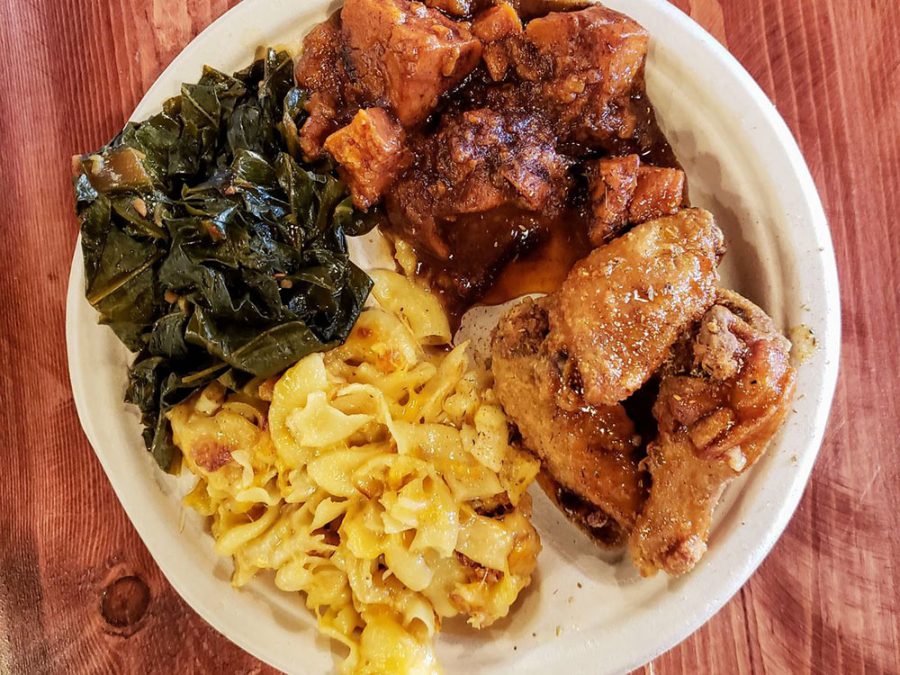From struggle to comfort: The origin of soul food
The origins of soul food cooking have its roots in the pre-colonial enslavement period of African people when enslaved Blacks had to make do with what they were given. While white slave owners got the meatiest cuts of ham, roasts, etc., Black slaves were only allotted the “leftover” and “undesirable” cuts of meat from their masters
November 20, 2021
As the holiday break swiftly approaches, the students at Alabama State University are beaming with excitement not only for completing another academic semester but also for the familial temptation of the steaming hot soul food that will be lining many students’ tables this year.
Every ethnic group has what it calls “soul food” – the nostalgic comfort foods that rekindle warm memories of family gatherings at the dinner table. However, in America, the term “soul food” commonly refers to traditional African American cuisine. Soul food is one of the most favored and recognizable types of cuisine in the United States. Since this country’s inception, Black Americans have passed on hearty, succulent recipes that have pronounced a special occasion.
Commonly described as fundamental, down-home cooking with roots in the rural South, some of the essential dishes of soul food cuisine include black-eyed peas, greens, cornmeal (used in cornbread, hush puppies, johnnycakes and as a coating for fried fish or chicken), okra, and pork. Martha Rial, from the Post-Gazette, describes her ideal soul food-inspired dinner as a meal that features “fried pork chops, collard greens garnished with red peppers, black-eyed peas, sweet potatoes and macaroni and cheese served with cornbread.”
Although many dishes and ingredients included in soul food are also regional meals that have emerged as a staple of southern American cooking, many Americans who are not familiar with this cuisine will likely confuse soul food with a description of Southern food. Still, there is a notable distinction. Bob Jeffries “Soul Food Cookbook” (1969) makes a keen differentiation and explains, “While all soul food is Southern food, not all Southern food is soul. Soul food cooking is an example of how really good Southern cooks cooked with what they had available to them.”
The origins of soul food cooking have its roots in the pre-colonial enslavement period of African people when enslaved Blacks had to make do with what they were given. While white slave owners got the meatiest cuts of ham, roasts, etc., Black slaves were only allotted the “leftover” and “undesirable” cuts of meat from their masters.
An article written in the Pittsburg Gazette explains how during the Transatlantic Slave Trade, enslaved African people were given meager food rations that were low in quality and nutritional value. With these rations, enslaved people preserved African food traditions and adapted traditional recipes with the resources available.
History.com notes that during the Middle Passage, slave traders intentionally took several crops native to Africa and made scarce amounts of these foods available on the slave ships in order to barely keep the slaves alive. Once in the Americas, the enslaved Africans grew these crops on the plantations as food sources that would keep their energy up during the long days of strenuous labor.
Scholars note a substantial African influence is found in soul food recipes, especially from the West and Central regions of Africa. This influence can be seen through the amount of spice found in many soul food dishes and several ingredients found within them. The peppers used to add spice to food included malagueta pepper, a seed-derived spice from West Africa. According to the Public Broadcasting System (PBS), this chili pepper is widely used in Brazil, the Caribbean, and Mozambique. Other spices native to the Western Hemisphere, such as red cayenne peppers, are commonly used in soul food as well.
Slaves were given the animal parts their masters disposed of. The intestines of the pig were cleaned and cooked, which became known as “chitterlings.” They took the butts of oxen and named them “oxtails.” Same thing for pigs’ tails, pigs’ feet, chicken necks, smoked neck bones, hog jowls and gizzards.
Pork remains a staple ingredient and is used in several soul food dishes. Many parts of the pig are utilized to create smoked neck bones, ham hocks, bacon, fatback and salt pork which are all still included in soul food menus, either as main dishes or to flavor foods such as vegetables and dried beans and peas. Pork fat is often used for frying and as an ingredient in slowly cooked greens.
Some students at Alabama State University weigh in on the impact that soul food has had on their family and personal lives.
“If you’re like me, you’re a sucker for soul food,” said sophomore psychology major Stephen Gore. “The idea of fried chicken, collard greens, and cornbread is enough to make my mouth water. That type of food just makes me remember a time when all the family can get together and enjoy each other’s company. Here in the south, most of us spend more time drooling over soul food than any other type of food.”
“Soul food has a rich and important history that ties Black culture to its African roots,” said junior political science major Daesha Bates, “When we eat soul food for the holiday, let us not disregard the historical link to America’s dark past and the horrors that our ancestors suffered while preparing these scraps to feed their family.”
Of course, soul food is not entirely defined by a racial divide. Historically, there has not been much of a difference between the foods eaten by poor black southerners and poor white southerners. An article written for Alliance by John T. Edge, director of the Southern Foodways, said, “The differences between the foods of black and white southerners are subtle. More capsicum pepper heat, a heavier hand with salt and pepper, and greater use of offal meat are comparative characteristics of soul versus country cooking.”
For the next 100 years after the abolition of slavery, Black Americans continued to make use of the ingredients that were now a large part of their traditional cooking. Many former slaves were poor and could afford only off-cuts of meat. PBS explains that farming, hunting and fishing provided fresh vegetables, fish and wild game, such as possum, rabbit, squirrel and sometimes waterfowl.
The intersectionality of African cuisine maintained social status amongst Black Americans during the New Jim Crow Era of American history. Laws that prevented equal treatment and racial divide prevailed. Blacks living in America post-slavery were impoverished and still had to make do with the food choices available.
Today, we can still see clear similarities between soul food and traditional African cuisine. Notably, one-pot rice recipes like jambalaya resemble Jollof, a wildly popular traditional dish in many West African countries. Other dishes, like okra, have grown to become a cornerstone of southern American cooking despite its African roots. Okra is still used today in various African soups, stews, and rice dishes, and the recipes vary widely from country to country. During the Atlantic slave trade, slaves were frequently given the task of preserving the meat. Pork has remained the choice meat in the South for centuries, and the preferred method of preserving the meat in the past was to salt and smoke it. As a result, many of the techniques in curing meat are said to have been developed by African-Americans of the era.
“Soul food is truly a homage to a dark period in the history of the United States,” said Jaylah Ware, senior business marketing major. “This tragedy resulted in a renowned cuisine created from the scarce ingredients available to the slaves and sharecropping Black families. Over time, these special traditional recipes have become the soul food dishes we are familiar with today. Let’s not forget that this food that is now associated with comfort and decadence was born out of perseverance and survival.”

















